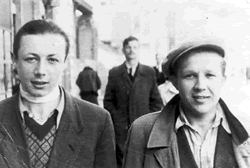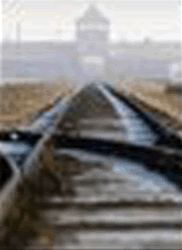Simcha Rotem ( nee Kazik Rathajzer)

members of the underground on a street on the "Aryan" side of Warsaw during
the war(Simcha Rotem- Kazik Rathajzer is on the left
Siewierski Stefan on the right and Yitzhak Zuckerman in the back.
Simcha Rotem (1924-present) also known as Kazik, the name he used as a member of the Jewish Underground in Warsaw, he served as the head courier of the Jewish Fighting Organization (ZOB), which planned and executed the Warsaw Ghetto Uprising against the Nazis.
Contents
* 1 Before World War II
* 2 The Second World War
* 3 Post-war life
* 4 Bibliography
Before World War II
He was born Szymon Ratajzer in 1924 in Warsaw, Poland and was 15 years old when Germany invaded Poland in 1939. The name "Kazik" is a name diminution from "Kazimierz" = Casimir. He used it as an alternative Polish name.
The Second World War
In 1942 he joined the Zydowska Organizacja Bojowa (ZOB). Because of his non-Jewish aryan looks and unaccented Polish, Rotem became particularly useful as a courier for the fighters of the Warsaw Ghetto and often conducted missions to rescue Jews dressed as a member of elite Polish units associated with the German Waffen S.S.. He took part in the Warsaw Ghetto Uprising. When it became apparent that all was lost, he was sent via a secret passageway to the aryan side of Warsaw to meet with ZOB commander Yitzhak Zuckerman to try to arrange an escape for the fighters. The passageway was discovered by the Nazis, however, and unable to return via that route, he and Zuckerman were trapped on the aryan side while the fighting raged and the ghetto burned. Desperate to reach their comrades, Rotem made several attempts to enter the ghetto through the sewers of Warsaw before finally succeeding. There he met one of the last surviving leaders of the ghetto revolt Zivia Lubetkin and he led her and her team of approximately 80 fighters through the sewers to the aryan side and then to the forests outside of the city. He became the head courier for the ZOB and second in command to Zuckerman. Throughout the rest of the war he continued his underground activities with the resistance, in particular helping to care for the several thousand Jews who still remained in Warsaw in hiding. In August 1944, he took part in the Polish Warsaw Uprising.
Post-war life
Immediately following the end of World War II, Rotem became a member of the "Avengers", a special squad made up of members of the Jewish Resistance during the war who tracked down and executed known Nazi war criminals in Europe. He took part in the organization of the Beriha, an organization that helped European Jews illegally immigrate to what was then called Mandate Palestine. Although his twelve-year old sister was murdered in the Warsaw Ghetto Uprising, his parents and another sister survived in hiding and, in 1947, he and the surviving members of his family immigrated to Israel. He now lives in Jerusalem.
Bibliography
Rotem, Simhah. Memoirs of a Warsaw Ghetto Fighter: The Past within Me. New Haven: Yale University Press, 1994.
[article in Polish
--
Holocaust 'Avengers' Reunite
Elderly Jewish Survivors Give Accounts Of Revenge On Nazis
JERUSALEM, Dec. 24, 2005
http://wallenberg.umich.edu/rotem.html
....As he said in his 1997 Wallenberg Lecture in Ann Arbor, "The thought of fighting in the ghetto was totally unrealistic and contrary to everything the word ghetto represents." But Kazik and his brave colleagues did decide to fight, even though fighting the Germans meant almost certain death. After the German invasion of Poland, Jews in and around Warsaw were gathered up and forced to live in an area that made up only about 3 percent of the city. There were more than 500,000 people living in squalor in the Warsaw ghetto. The first massive deportation began in 1942. Spies from the ghetto told young resistance fighters like Kazik that the trains traveling from the ghetto to the camps were leaving the camps empty. Kazik and other Zionist youth group members decided to revolt.
The Warsaw Ghetto Uprising began in April 1943. With mines, grenades, pistols, and Molotov cocktails, Kazik and the other Jewish fighters killed a number of Germans who came to attack the stronghold within the ghetto. Then the Germans attacked from outside the ghetto, burning down all the shelters and equipment the fighters had left. Kazik and some other surviving fighters tunneled outside the ghetto walls. However, that was not the end. "Unfortunately, we had no one to rely on except ourselves," Kazik recounts in his book, Memoirs of a Warsaw Ghetto Fighter. "In my innocence I had thought that by getting out of the ghetto I had accomplished the essence of my mission…but we were still at the very beginning."
He was at the beginning because of incredible selflessness. Kazik could have chosen to save himself, but he and the others who escaped decided to return to the ghetto through the sewers to save the remaining fighters. Crawling through the stench, Kazik reached the ghetto but found only ruins. Kazik continued, "My life passed before my eyes, like a film, at a frantic pace. I saw myself fall in battle as the last Jew in the Warsaw ghetto. I had begun to lose all thoughts of survival. With a sudden effort, I wrenched myself free of thoughts of suicide and decided to return to the sewers." There, Kazik encountered more Jewish fighters who had escaped. Although some of the fighters survived, the Nazis had killed most of them as they emerged from hiding.
The handful of remaining ghetto fighters was not yet safe. Still disguised as a Polish Gentile, and always wary of traitors and informers, Kazik continued to live in and around Warsaw, even escaping, through wit and luck, several detentions by the Gestapo. After Warsaw was liberated in January 1945, he learned of a miracle—his parents were still alive. Although his brother and one of his sisters had been killed, the family was among the few to emerge with even remnants intact. Kazik finally realized his boyhood dream of living in Israel by joining the clandestine Aliyah Bet immigration in 1946.
(WCBS)
Lessons Of Auschwitz
Interactive
Lessons Of Auschwitz
A look back at the notorious Nazi death camp where some 1.5 million people perished.

World War II
Interactive
World War II
Remembering the more than 50 million lives lost.
Answers.com
(AP) A group of elderly Holocaust survivors came forward with accounts of a death squad they formed after World War II to take revenge on their Nazi persecutors, recounting a brazen operation in which they poisoned hundreds of SS officers.
In a Friday broadcast on Israel Channel Two TV, the survivors, some of whom fought in the Warsaw Ghetto uprising, recalled hunting down SS officers in the dead of night. Disguised as British or American officers, they would drag the SS men out of their homes and execute them, they said.
In their largest operation, the group, code-named "the Avengers," received a large amount of arsenic from Paris and laced loaves of bread fed to hundreds of SS officers imprisoned in an American camp after the war.
They said they were also planning a broad operation in Dachau and Nuremberg, but the Jewish leadership in what would soon become Israel forced them to abandon the plan.
"I didn't see myself as a murderer, not then and not today," group member Simcha Rotem told Channel Two.
The broadcast focused on a rare reunion of the group that took place earlier this month in a Tel Aviv suburb. Sixty years after the end of World War II, with most of several dozen "Avengers" either dead or in their late 70s and 80s, Rotem told The Associated Press they gave into family pressure to recount their experiences to their children, grandchildren and other relatives.
Over the years, reports of such Jewish death squads have surfaced and several books have been written. The Israeli government has often turned a blind eye to the reports. Earlier this year, it refused a request from Poland to extradite a suspected death squad member.
Aaron Breitbart, senior researcher at the Simon Wiesenthal Center in Los Angeles, said the tale of the bread-poisoning plot is plausible.
"This is not a story that somebody is telling out of a hat. There was such a plan. We just don't know how close they got" to carrying it out, Breitbart said.
With just a handful of Avengers left, and their actions part of history, the elderly survivors feel they have nothing to lose by speaking publicly about their operations.
One of the few surviving members of the fighters in the Ghetto Uprising, Rotem spent the entire war battling the Nazis. At the end of the war, he went to Bucharest where he met Nava (Abba) Kovner, the head of a group of Avengers from eastern Poland who spent most of the war as partisan fighters.
"I don't remember how I found out that they were thinking of this idea, but I also had this idea," Rotem said. "We walked around for two or three hours and we agreed to things and we began to work. It was very simple."
Rotem, 81 and living in Jerusalem, took charge of a plan to poison to death 28,000 SS officers imprisoned by the Americans in Dachau and Nuremberg in Germany.
"I wanted to finish off the SS officers who were held by the Americans ... unfortunately we did not succeed," Rotem said.
But another plan, carried out in part by Joseph Harmatz, largely succeeded. Harmatz found work at a bakery that supplied bread to American-run prisoner camps.
He said he received arsenic in rubber bottles from Paris, which he then used to poison 3,000 loaves of bread. About 2,280 SS men ate the bread, he said, but couldn't say how many, or if any, died. News reports at the time said more than 200 people were hospitalized, but made no mention of deaths.
"We fled (the Nazis) and we took revenge," the elderly Harmatz told Channel Two in a raspy voice. "We saw ourselves as obligated not to leave Europe so we could settle accounts with the Germans.
Michael Bar-Zohar, author of a book, "The Avengers," published in 1967, said the bread poisoning was the group's biggest operation.
They also considered an attempt to poison the water supply of five German cities but decided against it, Bar-Zohar said. Rotem confirmed they had other plans that were called off because they were afraid of killing innocent people.
The group, which included about 40 members, was largely made up of Jews who spent the entire war fighting the Nazis, Bar-Zohar said.
"Their spirit hadn't been broken by the concentration camps," Bar-Zohar said. The camp survivors "didn't have the will or desire to avenge."

